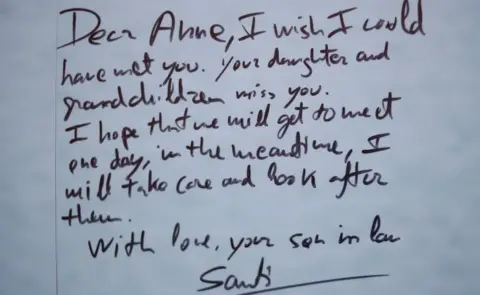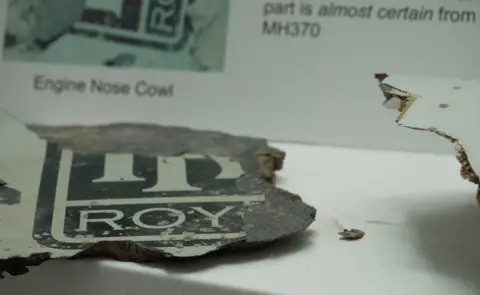MH370: The families haunted by one of aviation's greatest mysteries
 BBC/ Lulu Luo
BBC/ Lulu LuoFor the last decade, two words have haunted Li Eryou - lost contact.
It's what Malaysia Airlines told him when flight MH370 disappeared, with his son Yanlin on board.
"For years I have been asking what do you mean by 'lost contact'? It seems to me that if you lose contact with someone, you should be able to reconnect with them," Mr Li says.
He and his wife, Liu Shuangfeng - farmers from a village south of Beijing - have struggled to make sense of what has become one of the greatest mysteries in aviation history.
On 8 March 2014, less than an hour into a routine night-time flight from Kuala Lumpur to Beijing, the pilot said goodnight to Malaysian air traffic control. The Boeing 777, carrying 227 passengers and 12 crew members, was about to cross into Vietnamese air space.
It then abruptly changed direction, and all electronic communications were cut. It turned back, first over Malaysia, and then out into the remote southern Indian Ocean until it is presumed to have run out of fuel.
The biggest and most expensive search operation ever mounted lasted four years but failed to find any trace of the missing airliner. Thousands of oceanographers, aeronautical engineers and amateur sleuths have pored over the fragmentary data from the flight, trying to calculate where it ended its journey.
For the families of those on board these have been 10 years of inescapable grief, battling to keep the search going, to find out exactly what happened to MH370, and why.

Mr Li has crisscrossed the world in support of that campaign. He says he has used up his savings travelling to Europe and Asia, and to beaches in Madagascar, where some debris from the missing plane has been found.
He says he wanted to feel the sand in a place where his son might have washed up. He remembers shouting out at the Indian Ocean, telling Yanlin he was there to take him home.
"I will keep travelling to the end of the world to find my son," he says.
 BBC/ Lulu Luo
BBC/ Lulu LuoThe couple, now in their late 60s, live in a rural part of China's Hebei province. Most of their income went to pay for their children's schooling, and they never had the money to travel.
Yanlin was the first person in their village to go to university, and the first to get a job overseas, working in Malaysia for a telecom company.
He was returning to China for a visa appointment when the flight disappeared. "Before this incident happened, we had never even been to the nearby city of Handan," Mr Li says.
Now seasoned travellers, they came back to Malaysia to mark the 10th anniversary with other families.
Yanlin was one of 153 Chinese passengers on the flight. His parents are among around 40 Chinese families who have refused settlement payments from the Malaysian government, and have filed legal cases in China against the airline, the aircraft manufacturer and other parties.
Over 10 years, the lives of those affected have moved on, yet they also feel chained to the missing plane.
 Getty Images
Getty ImagesGrace Nathan was doing her final law exams in the UK when MH370 disappeared. Her mother Anne was on board. Today she is a barrister with her own practice in Malaysia, and a mother of two young children.
At the anniversary commemoration in Kuala Lumpur, she recalled holding her mother's photograph as she walked down the aisle at her wedding, and missing her advice while she was going through two difficult pregnancies.

On display there were a few battered pieces from the plane, the only physical evidence ever to be recovered from it. There were parts of the wing, corroded from their long immersion in the sea, with the surprisingly flimsy-looking internal honeycomb structure exposed.
In the crowd was Blaine Gibson, who has found more pieces of MH370 than anyone else.
One of a colourful cast of characters drawn into the MH370 saga, Mr Gibson can best be described as an amateur adventurer. He dresses in the style of Indiana Jones and has used the proceeds of the sale of his family home in California to fund his love of travelling, with a personal goal of visiting every country in the world.
"When I attended the one-year anniversary event I learned that there was no organised search of shorelines for floating debris. It simply hadn't been done. They were spending millions of dollars back then searching underwater. And I just thought, well, probably the first piece of this plane is just going to be found by someone walking on the beach. And since nobody was doing that, I thought I could do it myself."
He says he searched for a year, on beaches from Myanmar to the Maldives, before finding his first piece, from the rear stabilizer of the plane, on a sandbar in Mozambique.
By that time another large piece, known as a flaperon, from the wing, had already been found on Reunion Island, confirming to the families that MH370 had indeed crashed into the Indian Ocean.
The parts that were found were all discovered 16 months or more after MH370 vanished, washed up on various East African beaches.
 BBC/ Lulu Luo
BBC/ Lulu LuoAnalysis of the prevailing currents in the southern Indian Ocean showed they were likely to have come from where MH370 was believed to have crashed into the sea.
The former lead Malaysian investigator Aslam Khan explained how they identified them. Serial numbers on some parts were matched with records held by the manufacturer to confirm beyond doubt that they came from the Malaysia Airlines Boeing.
Distinctive fonts used in the stencil markings on others showed they were near certain to have come from it. No other Boeing 777 has ever crashed in the Indian Ocean.
Until the flaperon was found, the only evidence for the plane turning back on itself was data from military radar in Malaysia and Thailand, which spotted the plane flying west over the Malay peninsula.
Then a British company, Inmarsat, detected a series of six pings or "handshakes" made every hour between one of its satellites and MH370 as it headed south. All other communication on the aircraft had been switched off.
This sparse data was used to triangulate the distance between the plane and the satellite at each hour along a series of circular arcs, giving an approximate crash location. But this was still a huge area of very rough and very deep sea.
 Getty Images
Getty ImagesThe search, involving 60 ships and 50 aircraft from 26 countries, lasted from March 2014 until January 2017. It was resumed in early 2018 for five months by a private US-based company called Ocean Infinity, using underwater drones to scan the seabed.
The lack of hard information has fuelled many theories, some quite wild, about what happened on board MH370, from it being hijacked and flown to Russia, or perhaps to the US airbase on the island of Diego Garcia, to it being shot down.

"This is obscene," French journalist Florence de Changy muttered looking at the pieces of MH370 on display.
Ms Changy has written a meticulously researched book, one of more than 100 published on MH370.
She argues that the entire hypothesis that the plane turned and went south has been faked. She believes that the debris which has been found is not from MH370. She raises questions over the cargo on board, and in her book suggests that it may have been shot down by US aircraft over the South China Sea because of this cargo.
If, however, the radar and satellite data presented by Malaysia and Inmarsat is accepted at face value - and most experts do - and that the airliner kept flying south, there is only one plausible explanation. That someone flew it there deliberately.
 Getty Images
Getty ImagesIn a new BBC documentary, "Why Planes Vanish", two French aerospace experts, one an experienced pilot, have used a flight simulator to recreate the sharp turn the Boeing 777 made over the South China Sea, right after the last contact with Malaysian air traffic control. They have concluded that this could only have been done manually by a skilled and experienced pilot.
The fact that this was done just as MH370 was moving from Malaysian to Vietnamese air space suggests to them that the pilot was trying to conceal the manoeuvre. And that he knew it would be some time before Vietnamese air traffic control reported that they had not yet been contacted by the plane.
There are other theories - that everyone on board was knocked out by hypoxia, lack of oxygen, after an undetected depressurisation, or that a sudden catastrophic fire or explosion cut communications and forced the pilots to turn back. But the difficult manoeuvres, followed by continued, steady flight south for seven hours, make these very unlikely.
Yet the idea that one of the pilots deliberately flew the plane and all its passengers to a watery death is also hard to accept. Neither pilot had any history that could explain such an action.
All this feverish speculation has exacted a toll on the families.
"I would not wish this on my worst enemy," says Jaquita Gonzalez, wife of Patrick Gomes, the Inflight Supervisor on MH370.
"We have been going through such a rollercoaster. When they first started the search we would hear that they saw something, and then our hopes would be up high. And then after that we would hear no, it's not MH370. And we landed back on ground. Each time it was as if somebody had stood on top of us and taken our breath away."
 Lulu Luo/BBC
Lulu Luo/BBCFrom the start the Malaysian government was criticised by the families. First for its confused handling of the initial response, with blunders like the failure to act quickly on the military radar tracking of MH370. And later, for its apparent reluctance to authorise further searches, after the last operation by Ocean Infinity ended in mid-2018.
The company has offered to resume the search on a no-find, no-fee basis, but needs the government's approval.
Privately some Malaysian officials acknowledge that the government could have done more. Some of this can perhaps be explained by the country going through a period of extraordinary political turmoil in recent years. Then there was the pandemic, a huge distraction which also prevented the families from holding their annual commemoration.
The current transport minister, Anthony Loke, sought to address this by attending the 10th anniversary event in Kuala Lumpur, and promising the families he would do everything possible to find the missing plane. He announced that he was now discussing with Ocean Infinity the possibility of resuming the search later this year.
Ocean Infinity scanned an area of 112,000km, back in 2018. This though, encompassed some extremely challenging terrain, like deep underwater canyons, and it is possible it might have missed the aircraft.
Retired British aerospace IT specialist Richard Godfrey, another person who has been pulled into the MH370 vortex, believes he has now pinpointed a much smaller search area, using innovative analysis of short-wave radio test transmissions made routinely by ham radio enthusiasts. This should allow a more concentrated search by the drones, making several passes over the same area.
"They record 1.7 billion records a year in their database. Imagine a huge fisherman's net, across the globe, full of radio signals. Every time an aircraft passes through this net, it breaks a hole in the net. That tells me where an aircraft was at a particular time. Over the six hours of MH370's flight into the southern Indian Ocean I have been able to find 313 anomalies in the radio signals at 95 different points in time. That gives you a much more refined flight route, and a more accurate determination of a crash location."
Richard's method is currently being tested by the University of Liverpool, which expects to establish how valid it is later this year.
 BBC/ Jonathan Head
BBC/ Jonathan HeadThe families say they are encouraged by the latest promises made by the transport minister - a much-needed change of tone from the Malaysian government, they say. But they remain wary. Their hopes have been raised many times before.
"I just want the plane to be found," Ms Gonzalez says. "At least then I can let my husband rest in peace. Right now, I have not done anything for him, you know, to give him a memorial. I can't, because we don't have anything tangible from him."
At the commemoration a large board had been put up, on which people could write messages, of hope, of sympathy, or of grief.
Li knelt down to write a message to Yanlin in large Chinese characters, and then sat in tears, looking at it.
"Son, it's been 10 years", he had written. "Your mum and dad are here to bring you back home. March 3rd, 2024."

Ten years after Malaysia Airlines Flight MH370 and its 239 passengers and crew vanished, can new evidence help locate the plane and finally solve aviation's greatest mystery?
Watch now on BBC iPlayer (UK Only)

